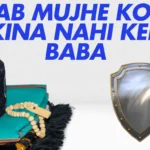Naat is an essential form of Islamic poetry, expressing love and devotion for the Prophet Muhammad ﷺ. The Naat titled Dar-e-Nabi Par beautifully captures the deep yearning of a believer for the Prophet’s ﷺ shrine and divine mercy.
| Mera Dil Badal De Lyrics-Junaid Jamshed |
| Ya Muhammad Noor E Mujassam Naat Lyrics |
| Noha Naat- Tu Na Aya Ghazi Lyrics |
| Noha Naat- Hussain Bant Rahe Hain Lyrics |
Verse-by-Verse Analysis of dar e nabi par naat lyrics in urdu
1. Longing for the Prophet’s ﷺ Shrine
“Dar-e-Nabi ﷺ Par Para Rahoon Ga, Parre Hi Rehne Se Kaam Hoga”
The poet expresses an unshakable resolve to remain near the Prophet’s ﷺ shrine. The phrase “Parre Hi Rehne Se Kaam Hoga” signifies the hope that persistence in seeking blessings will lead to success.
2. Divine Presence and Hope
“Khilafe Maashooq Kuch Huwa Hai, Na Koi Aashiq Se Kaam Hoga”
This verse highlights the struggles of love and devotion. The poet consoles the heart, affirming that Allah’s presence is everywhere, especially near the exalted station of the Prophet ﷺ (Aali Maqam).
3. The Pursuit of Meaning and Guidance
“Kiye Hi Jaoon Ga Arz Matlab, Milega Jab Tak Na Dil Ka Matlab”
Here, the poet vows to continue seeking until the heart is satisfied. The metaphorical reference to “Shaam E Matlab Ki Subha” depicts the eventual dawn of understanding after long nights of searching.
4. Devotion and Recognition
“Jo Dil Se Hai Ma’il-E-Payambar, Yeh Is Ki Pehchan Hai Muqarrar”
A believer’s true identity lies in their love for the Prophet ﷺ. The verse emphasizes the continuous recitation of Durood (blessings) and Salam (peace), highlighting its importance in the life of a devout Muslim.
5. Sustenance Through Divine Mercy
“Isi Tawaqqo Pe Ji Raha Hoon, Yehi Tamanna Jila Rahi Hai”
The poet lives with the hope of receiving the Prophet’s ﷺ merciful gaze (Nigah-e-Lutf-o-Karam). Without it, life feels unbearable, underscoring the deep reliance on divine compassion.


Themes in “Dar-e-Nabi Par”
- Love for the Prophet ﷺ: Every verse echoes the poet’s longing for closeness to the Prophet ﷺ and his shrine.
- Faith and Patience: The recurring theme of hope inspires believers to remain steadfast.
- Divine Connection: The lyrics beautifully intertwine devotion to Allah and love for the Prophet ﷺ.
Why This Naat Is Special
This Naat embodies the timeless devotion that countless Muslims feel for the Holy Prophet ﷺ. Its poetic structure blends deep spirituality with vivid imagery, making it relatable to anyone seeking a closer connection to Allah and His beloved Messenger ﷺ.
The Importance of Durood and Salam in Islamic Practice
- The Role of Naat in Islamic Culture
Naats hold a special place in Islamic spirituality, serving as a medium to express love for the Prophet ﷺ through poetic tributes. - Importance of Durood and Salam
Regular recitation of Durood is a vital practice in Islam, as it brings immense blessings to the reciter and elevates their spiritual rank. - Significance of Visiting Medina
The Prophet’s Mosque in Medina, often referred to in Naats, remains a central symbol of Islamic devotion and history.
FAQs:
Dar-e-Nabi” means “The Door of the Prophet ﷺ” in Urdu, symbolizing the sacred threshold of the Prophet Muhammad ﷺ’s shrine.
Naats serve as poetic expressions of love and devotion to the Holy Prophet ﷺ, inspiring Muslims to strengthen their faith and connection with Allah.
The Naat emphasizes the blessings of persistence, faith, and the spiritual elevation one experiences through devotion to the Prophet ﷺ and reciting Durood.




